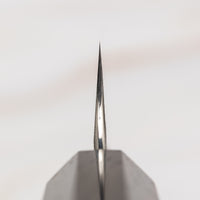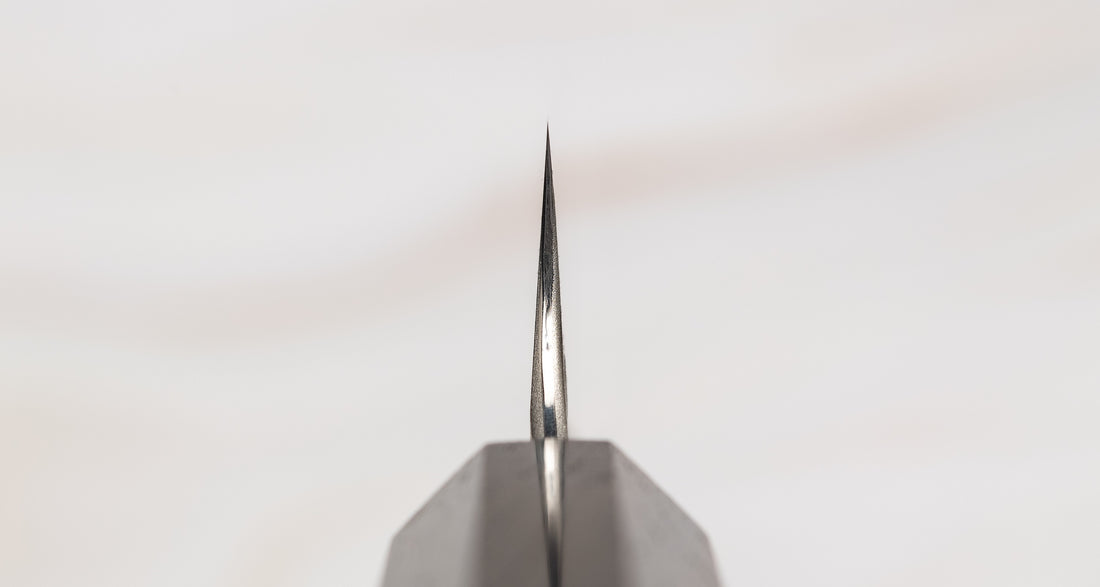


Nigara Kiri-Petty Aogami Super Migaki Tsuchime 120mm (4.7")
🚩 This blade will develop patina with use, while improper maintenance may lead to rust formation.
|
✔︎ No import fees & duties - worldwide |
- Description
- Specifications
- Knife Care
- Shipping
Looking for a knife that will impress you both in functionality and looks? Look no further. The knives of the Nigara AS Migaki Tsuchime line are more than impressive.
The look and feel of these knives will leave no one indifferent. The transition from the unique wave-like tsuchime hammered pattern into the matte shinogi line is dotted with tiny spots reminiscent of snow. They match beautifully with the silver hair line finish, which runs along the length of the blade just above the cutting edge, marking the separation between the softer and the harder, core steel.
The blade is fitted with a dark ebony Japanese handle, made from a single piece of smooth wood that feels polished to the touch and offers an unparalleled tactile experience with every cut.
The Nigara Kiri-Petty AS Migaki Tsuchime 120mm (4.7") is a small multi-purpose Japanese kitchen knife, suitable for all those tasks in the hand and on the cutting board for which larger knives seem unwieldy. Its AS high carbon steel core is incredibly hard and tough, retains its sharpness for a long time, and is easy to resharpen.
BLADE SHAPE:
Petty knives are designed for smaller tasks on and off the cutting board. It's an indispensable knife in any kitchen and can be used for peeling, mincing, paring, and decorating food. Petty or utility knives are basically a smaller version of gyuto or chef's knives. Due to the length of the blade, it can also be used as a stand-alone knife if you are uncomfortable with longer blades. A must-have knife in every kitchen!
Another feature that catches the eye is the reverse-tanto tip, also known as a “K-tip” (K for kiritsuke) that slopes downward from the spine and has some great practicality, as it enables precise and effortless work with the tip. The overall blade size much smaller, which differentiates it from a standard, flatter kiritsuke shape and makes it a sort of kiritsuke-petty hybrid.
Use for: peeling, trimming, garnishing, carving, chopping herbs, chopping garlic, slicing small pieces of dried meat, trimming meat, filleting small portions of fish, and similar tasks.
*The length of the cutting edge is 110mm (heel to point), but with this knife the length is measured from the edge of the handle to the tip of the blade, amounting to 120mm.
STEEL:
The centerpiece of this knife series is Hitachi's Super Blue Steel (Aogami Super), which ranks at the very top of quality Japanese steels. Aogami Super steel is extremely rich in carbon, which directly affects the blade's hardness. It also contains 0.4% vanadium which gives the steel more toughness.
Aogami Super is rated as the most advanced carbon steel on the market. High-carbon steels need more maintenance as they quickly develop a protective patina, and if not wiped and dried after every use, they will develop rust. But Nigara made it a bit easier for us. The two outer layers of softer steel are rust-resistant, which offers additional protection from rust, although the Aogami Super is still exposed at the very edge (the visible, curvy line on the bottom of the blade represents the line between core and outer steel).
This knife was heat-treated to the hardness of around 63 HRC. It is extremely hard steel, meaning that it retains super fine sharpness for a long time despite its extensive usage. In addition, due to the high carbon content, the knife is very easy to resharpen.
LAMINATION:
The core layer consisting of AS steel is sandwiched between layers of softer, stainless steel in a technique called san-mai - it is used to improve the blade's structural integrity and subsequent ability to withstand impacts and to prevent chipping. San-mai translates to “three layers” in Japanese, referring to a blade that is composed of a primary, inner layer of harder steel (hagane) and two secondary, outer layers of softer steel (jigane) that protect the prior.
GEOMETRY:
It has a double bevel (symmetrical) blade, so it is suitable for both left- and right-handed users. Based on the ratio between the surfaces (the location of the angle change), this knife's profile is classified as a flat V-edge type, which makes it less brittle and easier to resharpen.
BLADE FINISH:
The transition from the unique wave-like tsuchime hammered pattern into the matte shinogi line is dotted with tiny spots reminiscent of snow. They match beautifully with the silver hair line finish and the glossy cutting edge. The surface of the blade was treated with a special textured hammer, leaving complex geometric impressions on its upper part. It is a stunning technique that involves skillfully hammering the blade's surface to create captivating indentations, which—aside from the purely aesthetic—also has a distinct practical function of reducing friction and creating air pockets that diminish the sticking of food to the blade during cutting.
HANDLE:
The Japanese handle (Wa) is made from a single piece of rich dark ebony wood, renowned for its exceptional hardness and density, which makes it one of the most durable and resistant woods. It is polished to a high gloss, creating a luxurious and elegant appearance and smooth feel that fits into the hand seamlessly. With its octagonal shape, it is suitable for both left and right-handed users. Recently the number of manufacturers of such handles has decreased, making them difficult to find.
BLACKSMITH:
Nigara Hamono is a historic smithy with a 350-year tradition. It has been active in the city of Hirosaki since the early Edo Period, when it started making swords for the Tsugaru clan. With over a hundred forging shops in the region during that era, Nigara Forging stands as a testament to Tsugaru Uchihamono's rich history and artistry.
For more than 350 years, Nigara Hamono has been a distinguished family of swordsmiths. Initially appointed by the region of Tsugaru to craft Japanese swords, the smithy transitioned to knife-making after the traditional swordsmithing techniques gained recognition during World War II.
While sword production ceased in 1965, Nigara Hamono continues to preserve traditional forging techniques, showcasing its artistry through Honuchi knives – authentic Japanese knives made with traditional methods, which exemplify the skill and experience accumulated throughout numerous generations of blacksmiths.
With their crafted items being officially certified as Aomori Prefecture Traditional Crafts in December, 2007, Nigara Hamono stands as a living testament to the enduring traditional craftsmanship rooted in the town of Hirosaki, Japan.
The current head blacksmith of Nigara Hamono, Tsuyoshi Yoshizawa, who works alongside his father Toshi Yoshizawa, is an eighth-generation blacksmith with a passion for knives, art, and music. His famous Nigara Anmon design is the result of his love of Andy Warhol’s artwork.
Blade shape: Kiritsuke Petty
Steel type: Aogami Super
Blade construction: San-mai / v-edge / tsuchime, migaki
Hardness (HRC scale): 63
Overall length: 240mm (9.4")
Blade length: 110mm (4.3")
Blade height: 30mm (1.2")
Spine thickness: 2.2mm (0.09")
Weight: 75g (2.6 oz)
Handle length: 115mm (4.5")
Handle type / wood: Japanese (Wa) style / ebony
Kanji on the blade:
Blacksmith: Nigara Hamono
Location of the smithy: HIROSAKI / Aomori Prefecture / Japan
☝️ Japanese kitchen knives in our store are handmade from natural materials. Slight variations in color, texture, weight and other dimensions are possible. We try to give a good photographic representation of our products, however computer screen resolution and colors do vary, so products might not look exactly as they are seen on screen.

☝️ THIS KNIFE MAY DEVELOP PATINA
Knives made of carbon steels can, due to their low chromium (Cr) content, discolor and develop patina. The knife is the most sensitive when it is still new and a patina had not developed yet, but later, patina will protect the blade. These types of knives require a touch more care:
✔ Wipe it regularly with a clean and dry cloth (you can also do this during use).
✔ After use, rinse it with lukewarm water and wipe it dry.
✔ Coat it regularly with knife maintenance oil or plain refined sunflower oil.
✔ Store the knife by wrapping it in paper which will absorb moisture and protect the blade.
A patina is a thin layer that forms on the surface of oxidized steel and protects it from further oxidation. The patina should not be confused with rust. Patina protects the blade, while rust causes corrosion and deterioration of material, so it should be removed (see Rust erasers).
→ For in-depth information about patina, read our dedicated post on patina.
GENERAL KNIFE CARE TIPS:
Blade wear depends on the quality of steel, usage and maintenance of the blade. Japanese knives are made of high-quality steels. Follow these tips to keep your Japanese knife in top-notch shape:
✔ Use a wooden, plastic or rubber cutting board.
✔ After use, wash the knives and wipe them dry.
✔ For storage, use a knife holder or a protective knife sheath (saya).
✔ A good cutting technique is your best bet to prolong sharpness.
✔ Use sharpening stones to sharpen the knife.
❗️Don’t leave the knife in the sink. Wash it by hand.
❗️Don’t wash the knife in the dishwasher.
❗️Don’t use the knife on glass, ceramics, marble or steel surfaces.
❗️Don’t scrape the food off the cutting board with the edge of the blade. Use the spine of the knife instead.
❗️Knife is a tool intended for specific use - cutting food. It is not a can opener, screwdriver, trowel, wire cutter, hammer etc.
→ For more details, read our guide
on Maintenance of Kitchen Knives.
🤙 Contact us if you need some help. We reply within 1 business day.
SHIPPING RATES:
- €10 - flat worldwide rate with DHL Express (express delivery, 2-5 business days).
- FREE - all orders over €300 (DHL Express).
EXCEPTIONS:
See our Shipping page for more details.
DUTIES AND IMPORT TAXES:
We ship all orders DDP (duties & taxes paid). This means you will not be charged for any import fees and taxes (including VAT). All our prices are final. The price you see at checkout is the final price, no hidden costs.
DELIVERY TIME:
- Europe: 1-2 business days
- US & Canada: 2-4 business days
- Rest of the World: 3-5 business days
RETURNS:
Our return policy lasts 30 days. If more than 30 days have gone by since the day you received your order, unfortunately we can’t offer you a refund or exchange.
→ Read our SHIPPING & RETURNS policy for more info. We strive to solve any issues fast and with as little hassle for you. If you have some additional questions, please contact us.
Each knife comes with:
✔️ Instructions and knife care leaflet.
✔️ A preventive Band-Aid – the knives are very sharp! 😉
✔️ Original box from the blacksmith, which we wrap in an old Japanese newspaper sheet – so every knife is ready to be passed on as a gift as soon as it hits your doorstep!
✔️ We also offer a special gift wrapping option with the traditional Japanese washi paper.
Quiz
Still doubting which type of Japanese knife should best fit your needs?
We created a 5-steps quiz to help you find the perfect knife based on your cooking skills and the type of food you prepare.



